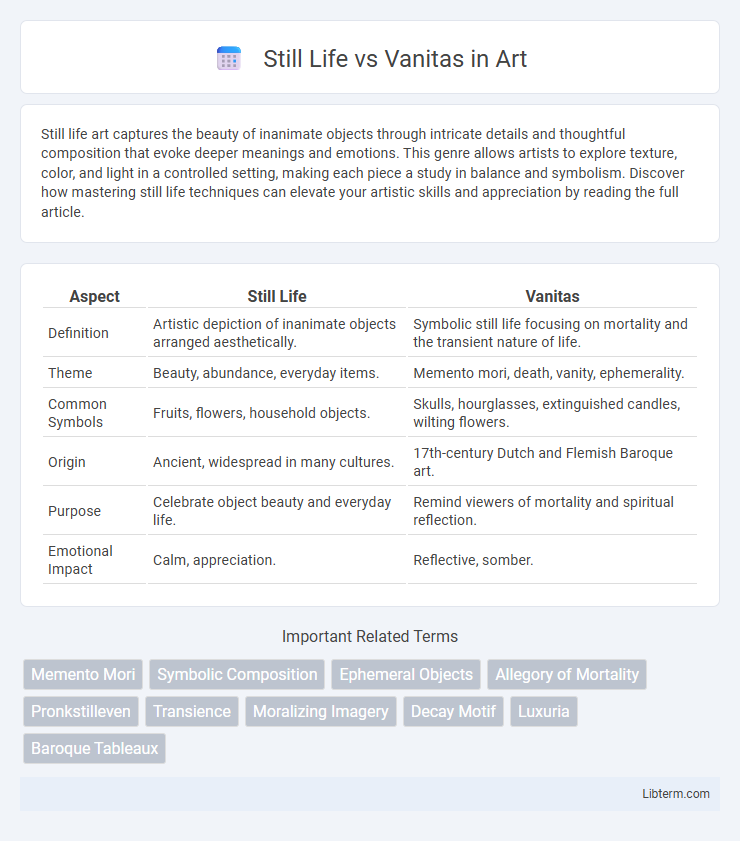Still life art captures the beauty of inanimate objects through intricate details and thoughtful composition that evoke deeper meanings and emotions. This genre allows artists to explore texture, color, and light in a controlled setting, making each piece a study in balance and symbolism. Discover how mastering still life techniques can elevate your artistic skills and appreciation by reading the full article.
Table of Comparison
| Aspect | Still Life | Vanitas |
|---|---|---|
| Definition | Artistic depiction of inanimate objects arranged aesthetically. | Symbolic still life focusing on mortality and the transient nature of life. |
| Theme | Beauty, abundance, everyday items. | Memento mori, death, vanity, ephemerality. |
| Common Symbols | Fruits, flowers, household objects. | Skulls, hourglasses, extinguished candles, wilting flowers. |
| Origin | Ancient, widespread in many cultures. | 17th-century Dutch and Flemish Baroque art. |
| Purpose | Celebrate object beauty and everyday life. | Remind viewers of mortality and spiritual reflection. |
| Emotional Impact | Calm, appreciation. | Reflective, somber. |
Introduction to Still Life and Vanitas
Still Life art captures inanimate objects with meticulous detail, emphasizing composition, texture, and light to highlight everyday beauty. Vanitas, a subgenre of Still Life, incorporates symbolic elements such as skulls, hourglasses, and wilting flowers to remind viewers of life's transience and the inevitability of death. Both genres showcase technical skill while conveying philosophical themes about existence and mortality.
Historical Origins of Still Life
Still life painting originated in ancient Egyptian tombs, evolving significantly during the Hellenistic period as artists explored everyday objects in detailed compositions. The genre gained prominence in 16th-century Europe, particularly in the Netherlands, where it reflected the growing interest in naturalism and material culture. Early still life works emphasize symbolic arrangements, setting the stage for the later development of vanitas paintings, which incorporated moral and philosophical themes.
The Emergence of Vanitas Paintings
Vanitas paintings emerged in the early 17th century as a subgenre of still life art, symbolizing the transience of life and the futility of earthly pleasures through motifs like skulls, wilting flowers, clocks, and extinguished candles. Originating primarily in the Dutch Golden Age, these artworks reflect Calvinist themes of mortality and moral contemplation, contrasting with traditional still lifes that celebrated wealth and abundance. Vanitas paintings serve as visual reminders of human mortality and the inevitable passage of time, emphasizing spiritual over material values.
Key Themes in Still Life Art
Still Life art primarily explores themes of everyday objects, emphasizing the beauty and temporality of mundane items through meticulous composition and lighting. Key themes include the celebration of material culture, the passage of time represented by perishable goods like fruit and flowers, and the exploration of texture and color to evoke sensory experiences. Still Life paintings often highlight the balance between abundance and simplicity, inviting viewers to contemplate objects' symbolic meanings within a static framework.
Symbolism in Vanitas Artworks
Vanitas artworks symbolize the transient nature of life through motifs such as skulls, wilting flowers, hourglasses, and extinguished candles, which represent mortality, decay, and the passage of time. These symbols emphasize the futility of earthly pleasures and material wealth, reminding viewers of inevitable death and the importance of spiritual reflection. The contrast between vibrant objects and symbols of death underscores the tension between life's beauty and its impermanence.
Artistic Techniques: Still Life vs Vanitas
Still Life paintings emphasize meticulous detail, vibrant color palettes, and precise lighting to showcase everyday objects with realism and clarity, often highlighting texture and composition. Vanitas artworks incorporate symbolic elements such as skulls, hourglasses, and wilting flowers, using contrasting light and shadow to evoke themes of mortality and the transience of life. Both styles employ careful brushwork and balanced arrangements, but Vanitas infuses deeper allegorical meaning through its symbolic iconography and dramatic chiaroscuro effects.
Famous Still Life Artists and Works
Famous still life artists such as Pieter Claesz and Willem Kalf are renowned for their detailed compositions exemplified by Claesz's "Vanitas Still Life" and Kalf's luxurious "Still Life with a Late Ming Ginger Jar." Vanitas paintings, a subset of still life, emphasize the transient nature of life using symbolic objects like skulls and hourglasses, with artists like Harmen Steenwijck leading the genre through works such as "Vanitas Still Life with a Rolling Stone." These masterpieces not only showcase technical skill but also embed moral messages about mortality and the futility of earthly pleasures.
Iconic Vanitas Painters and Masterpieces
Iconic Vanitas painters such as Pieter Claesz, Harmen Steenwijck, and Willem Claeszoon Heda elevated the genre by incorporating symbolic objects like skulls, extinguished candles, and hourglasses to emphasize the transient nature of life and material wealth. Masterpieces like Claesz's "Vanitas Still Life" and Steenwijck's "Vanitas Still Life with a Globe and a Skull" showcase meticulous detail and profound allegorical meaning, contrasting with traditional Still Life's focus on aesthetic depiction of everyday objects. Their works serve as memento mori, reminding viewers of mortality and the futility of earthly pleasures through expertly rendered symbolism embedded in Vanitas compositions.
Contemporary Interpretations of Both Genres
Contemporary still life and vanitas paintings blend traditional symbolism with modern themes, exploring consumer culture, mortality, and identity. Artists incorporate digital media, mixed materials, and abstract forms to reinterpret classic motifs like flowers, skulls, and decaying objects. This fusion challenges viewers to reflect on impermanence and the evolving relationship between life and death in today's society.
The Impact of Still Life and Vanitas on Modern Art
Still Life and Vanitas significantly influenced modern art by introducing symbolic complexity and a focus on everyday objects as carriers of deeper meaning. These genres encouraged artists to explore themes of mortality, materialism, and the passage of time through detailed representation and allegory, shaping modern artistic narratives. Contemporary artists draw on this legacy to challenge perceptions, blending realism with conceptual depth in their work.
Still Life Infographic

 libterm.com
libterm.com